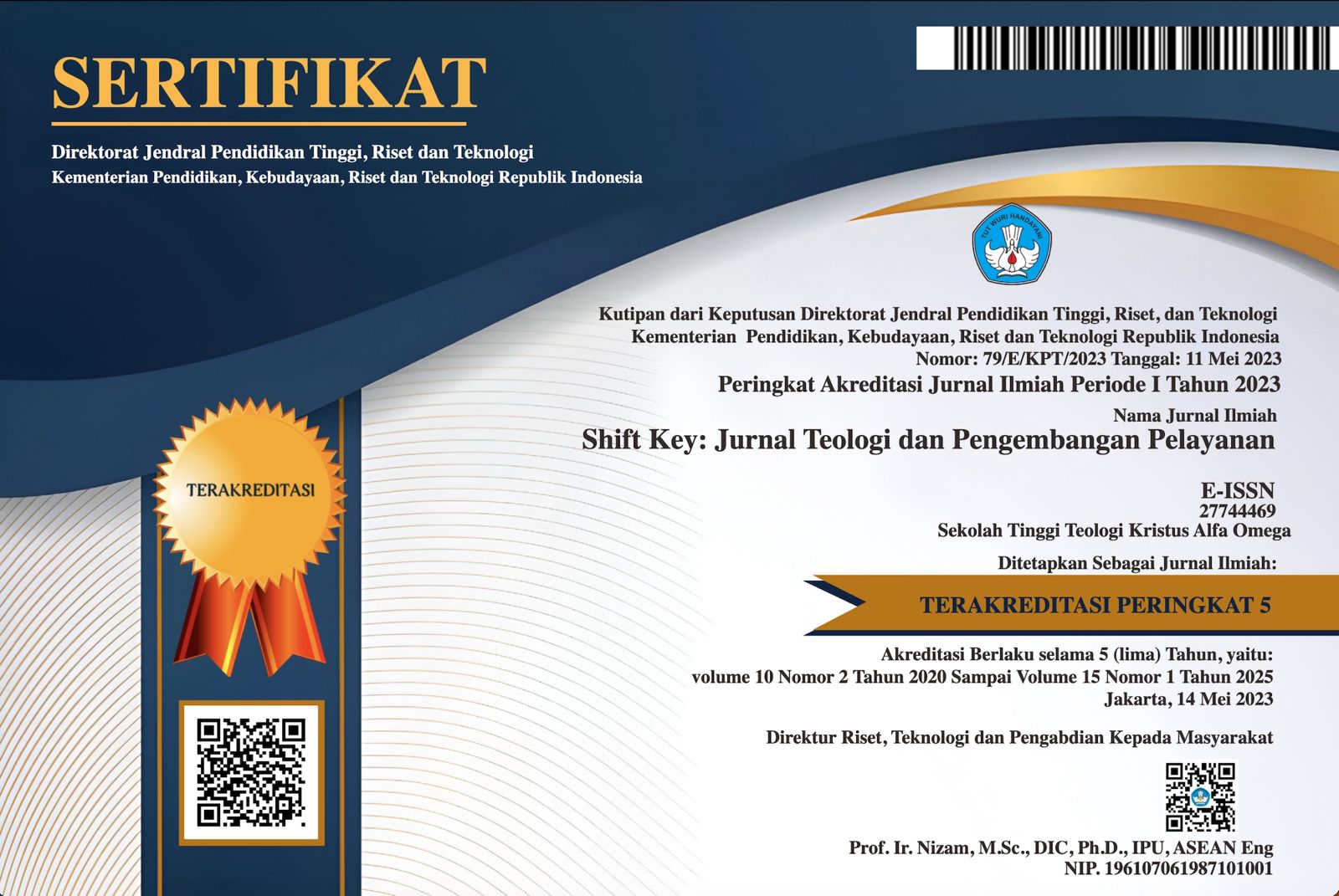Author Guidlines
PURPOSE AND SCOPE OF ARTICLE
Shift Key: Jurnal Teologi dan Pengembangan Pelayanan accepts scholarly manuscripts in the form of original research articles and critical theological reflections that contribute significantly to the advancement of theology and Christian ministry in both global and local contexts. Submitted manuscripts must demonstrate academic relevance, novelty, and scientific contribution consistent with the journal’s focus and scope, which include topics such as Biblical and Systematic Theology, Evangelism and Church Planting, Christian Ethics and Ecotheology, Effective Educational Strategies for Children, Adolescents, Youth, and the Elderly, Christian Education Curriculum, Technology in Learning, Methods of Music Ministry and Worship in the Modern World, as well as Development of Holistic and Global Ministry and Interdisciplinary Education. Each manuscript is expected to present a coherent integration of scientific inquiry, theological reflection, and practical implications for church and community service. The journal emphasizes the integration of academic scholarship and contextual relevance, aiming to support theological renewal and effective Christian ministry in addressing contemporary challenges.
ARTICLE STRUCTURE (Template; bit.ly/42uwR6i )
Title
The title must reflect the main study and variables, be concise yet specific, attractive, and relevant to current issues. It should not include uncommon abbreviations and must use formal academic language. Each word in the title begins with a capital letter, written in Times New Roman, size 12, with 1.15 spacing. The title should not exceed 12 words and should not mention the research location, year, or numbers. Avoid using generic terms such as “influence,” “study,” or words commonly used in theses or dissertations. Metaphorical expressions should also be avoided. The title must be centered on the page.
Author Identity
The author’s identity must be written clearly and completely, including the full name as it appears in academic records (without titles), institutional affiliation (university/seminary), and the active email address of the corresponding author. If there are multiple authors, list the names according to their contribution and clearly indicate the first author and corresponding author. The author’s name should be written in Times New Roman, size 11, bold.
Abstract
The abstract should briefly present the main research problem, research objectives, methods used, and the main findings (novelty), without citations. The language must be clear, objective, and free from unexplained abbreviations. The abstract should be written in both Indonesian and English (in italics), centered, using Times New Roman, size 10, single spacing. It must be one paragraph, ranging from 150 to 200 words. Below the abstract, provide at least four keywords, separated by commas, without a period at the end.
Keywords: Keywords are important terms or phrases in the article that reflect the research focus and facilitate indexing and article searches. Each keyword should be separated by commas, without a period at the end.
A. INTRODUCTION
The introduction must present a clear and relevant background of the problem, followed by a brief review of previous studies (state of the art) to show the position of the research. Authors should identify the research gap and explicitly highlight the novelty and contribution of the study to the development of knowledge or practice. This section concludes with a specific statement of the research objectives. The paper margin must be set to: top 3 cm, left 3 cm, right 2 cm, bottom 2 cm. The text must be justified, written in Times New Roman, size 11, with 1.5 spacing. Each paragraph should have a minimum of six lines, with the first line indented 1.5 cm. The space between the last sentence of a paragraph and the next subheading should be one line (as shown in the format example). The introduction should consist of a maximum of five paragraphs. No paragraph may end with a citation. References must be written in footnotes using a reference manager such as Mendeley, with the Turabian 8th Edition style, Times New Roman size 8, single spacing, and a hanging indent of 1.5 cm.
B. METHODOLOGY
The methodology must be written clearly, in detail, and systematically so that it can be replicated by other researchers. This section should include the research objectives, method, research type, stages of research, location and subject/object of study, data collection techniques, instruments (brief and simple), and data analysis procedures. For quantitative studies, describe the sampling methods, variables, and statistical analysis techniques; for qualitative studies, explain data validation techniques such as triangulation or member checks. The methodology must be consistent with the research objectives, follow research ethics, and be written in concise, academic language.
C. DISCUSSION
The discussion should be systematic, critical, and analytical, linking the findings to relevant theories, concepts, and previous studies. Authors must show how the findings support, challenge, or expand prior research, citing updated references (within the last 5–10 years, from Sinta 1–2 or Scopus journals). The discussion should not merely restate the results but should elaborate on their meaning, theoretical implications, and practical relevance. Authors are encouraged to explicitly highlight the novelty of their study and emphasize its contribution to the development of knowledge, practice, or policy. Comparative and argumentative analysis is strongly emphasized, such as comparing results with literature, contextual conditions, or field practices. Suggested structure: (1) state the main findings; (2) connect them to previous research or theory; (3) explain the similarities or differences; (4) describe academic and practical implications; (5) emphasize contributions and limitations. In this way, the discussion forms a logical scientific narrative, demonstrating originality and providing directions for further research.
D. CONCLUSION
The conclusion must provide a concise and clear answer to the research questions or objectives, not a summary of the entire article. It should be written as a narrative paragraph (not in bullet points), emphasizing the core findings and their scientific contribution. The conclusion should highlight the novelty of the study, whether in theory, methodology, or practical implications. It must be synthetic, connecting the findings to a broader academic or social context, and demonstrating their relevance to the discipline. It may also provide brief recommendations for further research or practical applications but must not introduce new data not previously discussed.
REFERENCES
All references cited in the text must be included in the reference list. The references should consist primarily of primary sources (journal articles, at least 80% of the total) published within the last ten years. Both footnotes and the reference list must be managed using Mendeley (or another reference manager) in Turabian 8th Full Edition style.
PUBLICATION PROCESS

The publication process in Shift Key: Journal of Theology and Ministry Development is carried out rigorously and transparently through the Open Journal System (OJS), following the stages below:
- Registration and Manuscript Submission (Submission Stage)
The author registers an account in the OJS system and uploads the manuscript in accordance with the journal’s template and author guidelines. Each submission must be accompanied by a statement of originality and publication ethics compliance. - Initial Evaluation by the Editor (Preliminary Evaluation)
The Editor-in-Chief evaluates the manuscript’s initial suitability with the focus and scope of the journal, administrative completeness, and potential scholarly contribution. Manuscripts that do not meet these criteria will be desk rejected, while qualified manuscripts are forwarded to the Section Editor. - Assignment of Section Editor (Editorial Assignment)
The Editor-in-Chief assigns a Section Editor according to the manuscript’s subject area to manage the editorial process. - Pre-Review Manuscript Refinement (Pre-Review Editing)
After receiving the assignment, the Section Editor conducts an initial assessment and editing to ensure that the manuscript meets the required format, structure, language quality, and clarity.
The Section Editor provides pre-review feedback to the author for technical and minor substantive corrections so that the manuscript is ready for peer review. - Reviewer Selection (Peer Reviewers Assignment)
The Section Editor appoints two or more peer reviewers from outside the publisher’s institution based on their expertise, using a double-blind review system in which both author and reviewer identities remain confidential. - Peer Review Process (Review Process)
Reviewers evaluate the manuscript in terms of novelty, academic relevance, methodological accuracy, depth of analysis, and scientific contribution. Reviewers provide recommendations as: accept as is, minor revision, major revision, or reject. - Manuscript Revision by the Author (Revision Stage)
The author revises the manuscript according to the reviewers’ comments and resubmits the revised version through the OJS platform. - Post-Review Evaluation (Revision Verification)
The Section Editor verifies the revised manuscript and may request additional review if necessary. Once the manuscript is deemed acceptable, it is forwarded to the Editor-in-Chief. - Copyediting and Proofreading (Language and Format Check)
Accepted manuscripts undergo copyediting and proofreading to ensure language accuracy, adherence to journal style, and consistency in citations and references. This process is handled by the Copyeditor and Proofreader. - Final Editing and Publication Approval (Final Editing and Approval)
The Editor-in-Chief conducts the final review of the edited manuscript to ensure content integrity, scientific quality, and compliance with publication standards before granting approval for publication. - Online Publication (Online Release)
The final version of the article is published online through the OJS platform, complete with a Digital Object Identifier (DOI), full metadata, and a Creative Commons (CC BY-SA) license. - Dissemination and Indexing (Visibility and Indexing). Published articles are disseminated and indexed through platforms such as Garuda, Crossref, Google Scholar, DOAJ, and Dimensions, to enhance visibility, accessibility, and scholarly impact.





